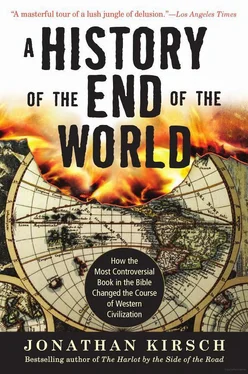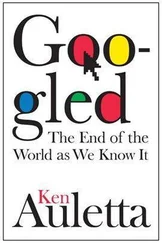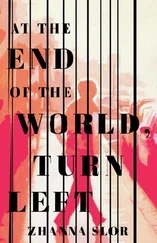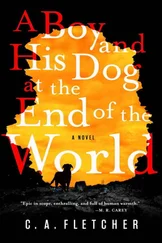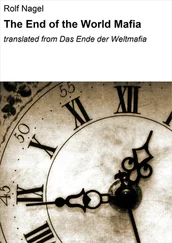The front line in the battle over Revelation has always been drawn between the authority of the church and the ragtag army of unruly Bible readers who insist on coming to their own conclusions about its veiled inner meanings. That is why, as we shall see, Revelation has always been the “text of choice” for religious eccentrics who see their own time as the end-time, ranging from Montanus in the second century to David Koresh in the twentieth century, and countless others in between.
“There has never been a book provoking more delirium, foolishness, and irrational movements, as if this book contained the possibility of a temptation actually demonic,” complains French political scientist and Protestant theologian Jacques Ellul, whose words apply with equal force to the Montanists and the religious fanatics of the third millennium. “Too often the Apocalypse excites our curiosity, unbridles our imagination, arouses our appetite for mystery, and finally hides from us the central truth which ought to be revealed.” 57
At the same time, Revelation turned out to be so crucial to Christian theology that it simply could not be ignored. “Revelation is not a nice book, nor in any conventional sense is it morally edifying,” observes historian and Bible scholar Donald Harman Akenson in his revolutionary rereading of Jewish and Christian scripture, Surpassing Wonder: The Invention of the Bible and the Talmuds. Yet he describes the inclusion of Revelation in the Christian canon as “an architectural master stroke” precisely because Revelation fundamentally reorients the rest of Christian scripture. “The book forces one to read the entire text of the ‘New Testament’ as an apocalypse,” Akenson explains, “which starts with the birth of Jesus and ends with Christ’s kingdom in eternity.” 58
By the fourth century, however, the church authorities decided to do something about the fact that the book of Revelation continued to work its powerful and provocative magic on the hearts and minds of the most excitable men and women among the laity. So they came up with a simple and convenient rule to govern the reading of Revelation. A good Christian, they taught, must not commit the error of reading Revelation “carnally”—that is, taking John’s visions of the end-times literally. Instead, the book of Revelation must be read “spiritually”; that is, Revelation must be understood as an allegory rather than a plain depiction of what will actually happen when the world comes to an end.
The rule represents an earnest effort to defuse the ticking time bomb that sputters away in the text of Revelation. The full weight of church authority and, eventually, the terrible threat of the Inquisition were brought to bear in enforcing the rule on the laity, but never with complete success. Ironically, the willful and unruly Christians who insisted on reading Revelation “carnally” were defying not only the dogma of the Roman Catholic Church but also the clear instructions of the author himself.
At a certain crucial moment in the book of Revelation, John describes a vision of what will take place in an unnamed city in the end-times. The “Gentiles”—a term used in the Hebrew Bible for non-Jews—will “tread the holy city underfoot” for a period of forty-two months, John is told by an angel. Then two anonymous “witnesses” will be given the power to prophesy for a period of exactly 1,260 days. As soon as the two witnesses are finished with their prophecies, “the beast that ascends from the bottomless pit will make war upon them and conquer them and kill them.” Their bodies will lay unburied in the streets for three and a half days, and then they will be resurrected and called to heaven by a divine voice. 59
“At that hour there was a great earthquake, and a tenth of the city fell,” writes John, describing the divine catastrophe that he has glimpsed in his visions. “Seven thousand people were killed in the earthquake, and the rest were terrified and gave glory to the God of heaven.” 60
John never actually identifies the place that he sees in his vision, referring only to “the great city, which is spiritually called Sodom and Egypt.” Some translators render the word spiritually as allegorically because, in fact, John is signaling his readers and hearers that both of these place names are purely symbolic. And he reveals the intended meaning of the symbolic names by describing the “great city” as the place where “our Lord was crucified.” To put it plainly, when the author of Revelation says “Sodom” and “Egypt,” he means Jerusalem—that is, the earthly city under the occupation of pagan Rome—but he says it allegorically rather than literally. 61
It’s hardly the most celebrated line of text in the book of Revelation, but it is arguably among the most illuminating ones. Here, as elsewhere in the book of Revelation, John makes it clear that the names, numbers, colors, and images in his visions are ciphers that must be decoded to yield their actual meanings. Montanus may have expected to see the celestial Jerusalem float down through the clouds above Pepuza and bestir the Phrygian dust when it came to rest on solid ground—but only because he failed to heed John’s warning to read the book of Revelation “spiritually.”
Indeed, John himself is given a short course in the interpretation of dreams and visions by his own heavenly mentors. At first glance, for example, John is astounded and bewildered by the sight of the seven-headed beast on which the Whore of Babylon rides. “Why marvel?” says an angel. “I will tell you the mystery of the woman and of the beast that carries her.” And it turns out that the seven heads of the beast are merely symbols that are meant to represent, among other things, seven earthly kings. 62And Jesus himself explains the “mystery” of the seven stars and the seven golden lamp stands that John sees in his very first vision: they are merely symbols for the seven earthly churches that John is called upon to address. 63
Still, John knows how to work a crowd, and he surely means to manipulate the fears and longings of his audience with scenes of sexual excess, violent persecution of Christians by pagan authorities, and equally violent revenge by God against their persecutors. And the early church fathers saw for themselves how the potent words and images of Revelation were capable of moving some men and women to dreams and visions of their own. When they cautioned good Christians to engage in a “spiritual” rather than a “carnal” reading of Revelation, they were struggling to make it safe for human consumption—and thus began the long, ardent, but failed enterprise that one scholar calls the “taming” of the apocalyptic tradition. 64
Reading a sacred text as an artful allegory rather than the plain truth was an ancient and honorable notion in the Greco-Roman world, and it was embraced by both Jewish and Christian scholars and theologians, including Philo of Alexandria in Jewish tradition and Origen and Jerome in Christian tradition. Thus, for example, the Bible literalists who projected themselves into the passages in Revelation where the saints and martyrs are shown to reign alongside Jesus Christ in the millennial kingdom—“They think they are to be kings and princes,” complains Origen, “like those earthly monarchs who now exist”—were condemned for “refusing the labor of thinking.” 65
But the “spiritual” approach to scripture was given its most complete and commanding expression by a forgotten figure called Tyconius, a late-fourth-century Christian cleric whose writings are now mostly lost but whose teachings cast a long shadow over the book of Revelation. Tyconius taught that the terrible and glorious images and incidents in Revelation—the demonic monsters, the celestial warriors, the final battle between God and Satan, and the thousand-year reign of Jesus—must be understood as symbolic expressions of an ongoing struggle between good and evil rather than a literal account of things to come. For Tyconius, the Whore of Babylon and the Bride of the Lamb were nothing more than convenient glyphs for distinguishing between ordinary human beings whose lives were godly or satanic.
Читать дальше
